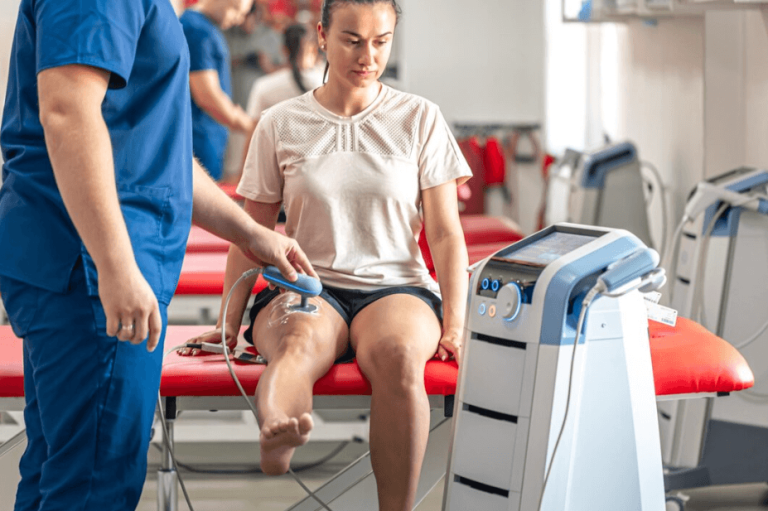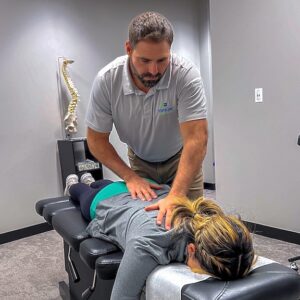Have you ever wished there was a way to improve your joint function and mobility without invasive procedures or lengthy recovery times? Well, look no further because soft wave therapy might just be the solution you’ve been searching for.
This innovative treatment utilizes low-intensity sound waves to stimulate tissue repair and promote healing in the joints. But how exactly does it work, and what conditions can it effectively treat?
In this discussion, we will explore the science behind soft wave therapy Rockford, its benefits for joint function, and how it compares to other treatment options. Get ready to discover a non-invasive alternative that could potentially transform your quality of life.
The Science Behind Soft Wave Therapy
Soft Wave Therapy utilizes high-energy acoustic waves to stimulate healing and promote joint function and mobility. The science behind this therapy lies in its ability to trigger a series of biological responses within the body. When the acoustic waves are applied to the affected area, they create microtrauma, which initiates an inflammatory response. This response activates the body’s natural healing mechanisms, increasing blood flow and promoting the delivery of important nutrients and oxygen to the injured area.
As a result of this increased blood flow, soft wave therapy can improve joint function and mobility. The acoustic waves help to break down scar tissue and stimulate the production of collagen, a protein that’s crucial for the health and strength of connective tissues. By promoting the growth of new blood vessels and encouraging tissue regeneration, soft wave therapy can effectively reduce pain and stiffness in the joints, improving overall mobility.
The science behind soft wave therapy is constantly being researched and refined. Studies have shown promising results, with patients experiencing significant improvements in joint function and mobility. This non-invasive and drug-free treatment option offers a safe and effective alternative for individuals seeking relief from joint pain and limited mobility.
With ongoing advancements in the field, soft wave therapy continues to evolve as a valuable tool in promoting joint health and improving overall quality of life.
How Soft Wave Therapy Works
Soft wave therapy operates by utilizing high-energy acoustic waves to stimulate healing and promote joint function and mobility. These acoustic waves, also known as shockwaves, are generated by a device and applied to the affected area of the body. When the waves come into contact with the tissues, they create microtrauma, triggering a healing response in the body.
The therapy works by improving blood circulation in the affected area. The high-energy waves stimulate the growth of new blood vessels, increasing the supply of oxygen and nutrients to the injured tissues. This enhanced blood flow helps in the removal of toxins and waste products, promoting healing and reducing inflammation.
Furthermore, soft wave therapy also stimulates the production of collagen, a protein that plays a crucial role in joint function and mobility. Collagen helps in strengthening the tendons, ligaments, and cartilage, providing support and stability to the joints.
The therapy also works by reducing pain. The acoustic waves disrupt the pain signals being sent to the brain, providing relief from discomfort. Additionally, soft wave therapy can stimulate the release of endorphins, which are natural pain-relieving chemicals produced by the body.
Conditions Treated by Soft Wave Therapy
Soft wave therapy has been shown to effectively treat a variety of conditions related to joint dysfunction and mobility. This innovative treatment can provide significant improvements in your overall joint health and wellness. Whether you’re dealing with chronic pain, limited mobility, or reduced joint function, soft wave therapy offers a non-invasive and drug-free solution.
One of the primary conditions that can benefit from soft wave therapy is osteoarthritis. This degenerative joint disease can cause pain, stiffness, and limited range of motion. Soft wave therapy can help stimulate the repair process within the joints, reducing inflammation and promoting healing.
Another condition that soft wave therapy can address is tendonitis. Tendonitis is the inflammation of the tendons, which can result in pain and restricted movement. By increasing blood flow and promoting tissue regeneration, soft wave therapy can alleviate pain and restore proper tendon function.
Soft wave therapy is also effective in treating joint injuries, such as sprains or strains. These injuries can disrupt joint function and limit your mobility. Soft wave therapy accelerates the healing process by promoting the growth of new blood vessels and collagen, aiding in tissue repair and reducing pain.
Benefits of Soft Wave Therapy for Joint Function
If you’re dealing with joint dysfunction or limited mobility, soft wave therapy offers a range of benefits that can improve your overall joint function and mobility. Soft wave therapy is a non-invasive treatment that uses acoustic waves to stimulate healing and promote tissue regeneration in the affected joint.
One of the key benefits of this therapy is pain relief. By targeting the source of your joint pain, soft wave therapy can help reduce inflammation and discomfort, allowing you to move more freely.
Additionally, soft wave therapy can improve joint flexibility and range of motion. The gentle waves stimulate blood flow to the joint, which promotes the growth of new blood vessels and the delivery of important nutrients to the damaged tissues. This can help improve joint function and restore mobility.
Soft wave therapy is also a safe and effective alternative to more invasive treatments such as surgery or medication. It has minimal side effects and doesn’t require any downtime or recovery period.
If you’re considering soft wave therapy, it’s important to consult with a caring doctor who specializes in this type of treatment. They can evaluate your specific condition and develop a personalized care plan to address your joint dysfunction and improve your mobility.
Soft Wave Therapy Vs. Other Treatment Options
When comparing treatment options, soft wave therapy stands out as a safe and effective alternative to more invasive methods for improving joint function and mobility. Unlike surgery or joint injections, soft wave therapy doesn’t require any incisions or injections into the joint. This means that there’s no risk of infection, bleeding, or other complications associated with invasive procedures.
Soft wave therapy also doesn’t involve the use of medications, which can have side effects and interactions with other drugs. Instead, soft wave therapy utilizes acoustic waves to stimulate the body’s natural healing process and promote tissue regeneration. This non-invasive approach makes soft wave therapy a more comfortable and convenient option for patients.
Furthermore, soft wave therapy has been proven to be effective in improving joint function and mobility in various clinical studies. It has been shown to reduce pain, increase range of motion, and enhance overall joint function.
In comparison to other treatment options, soft wave therapy offers a non-invasive and drug-free solution that can provide long-lasting results for patients suffering from joint problems.
What to Expect During a Soft Wave Therapy Session
During a soft wave therapy session, you can expect a comfortable and non-invasive procedure that promotes tissue regeneration and enhances joint function. The session typically takes place in a clinic or a healthcare facility, where a trained professional will administer the therapy.
You will be asked to lie down or sit in a comfortable position, depending on the area being treated. The therapist will then apply a handheld device that emits low-intensity shockwaves to the affected area. These shockwaves penetrate deep into the tissues, stimulating blood flow and promoting the production of growth factors that aid in tissue repair.
The therapy itself is painless, although you may feel a slight tingling or warmth in the treated area. Sessions usually last for about 15 to 30 minutes, and multiple sessions may be required depending on the severity of your condition.
After the session, you can resume your daily activities immediately as there’s no downtime associated with soft wave therapy. It’s important to follow any post-treatment instructions provided by your therapist, such as avoiding strenuous activities or applying ice to the treated area.
Does Soft Wave Therapy Have Any Side Effects?
Soft wave therapy typically doesn’t have any significant side effects. This non-invasive treatment option is generally well-tolerated and safe for most individuals. The low-intensity sound waves used in soft wave therapy specifically target damaged tissues and promote healing without causing harm to surrounding healthy tissues. As a result, the risk of adverse reactions or complications is minimal.
In some cases, individuals may experience mild discomfort during the soft wave therapy session. This discomfort is usually temporary and resolves quickly after the treatment is completed. It’s important to communicate any discomfort or concerns with your healthcare provider to ensure that the therapy is adjusted to your comfort level.
Rarely, individuals may experience mild bruising or skin irritation in the treated area. However, these side effects are generally mild and short-lived. It’s important to note that these side effects are significantly less common compared to other more invasive treatment options, such as surgery or injections.
Soft Wave Therapy: A Non-Invasive Alternative
If you’re looking for a non-invasive alternative for promoting joint function and mobility, soft wave therapy may be the solution for you. This innovative treatment utilizes the power of sound waves to stimulate healing and improve the overall health of your joints.
Unlike invasive procedures such as surgery, soft wave therapy is a safe and painless option that doesn’t require any incisions or anesthesia.
The therapy works by delivering low-intensity shock waves to the affected area, which triggers a healing response in your body. These shock waves promote blood flow, stimulate the production of growth factors, and enhance tissue regeneration. By targeting the root cause of your joint pain or dysfunction, soft wave therapy can effectively alleviate symptoms and improve your mobility.
One of the key advantages of soft wave therapy is that it can be used on various joints in the body, including the knees, hips, shoulders, and elbows. Whether you’re suffering from arthritis, tendinitis, or other joint conditions, this non-invasive treatment can provide relief and restore function to the affected area.
Another benefit of soft wave therapy is that it has minimal to no side effects. Unlike medications or invasive procedures, soft wave therapy doesn’t carry the risk of adverse reactions or complications. It’s a safe and gentle approach that can be used as a standalone treatment or in combination with other therapies to enhance your overall results.
Soft Wave Therapy Success Stories
Patients who’ve undergone soft wave therapy have experienced remarkable improvements in joint function and mobility. Countless success stories have emerged, showcasing the effectiveness of this non-invasive treatment.
For instance, imagine being able to walk pain-free after years of struggling with knee arthritis. That’s exactly what happened to John, a 55-year-old patient who’d been suffering from chronic knee pain. After a few sessions of soft wave therapy, he noticed a significant reduction in pain and swelling. Not only did he experience an improved range of motion, but he also regained the ability to participate in activities he once loved, such as hiking and playing sports.
Another success story involves Sarah, a 40-year-old woman diagnosed with rotator cuff tendinitis. Soft wave therapy helped alleviate her shoulder pain and increased her strength and mobility. Sarah is now able to perform everyday tasks without discomfort and even resumed her yoga practice.
These stories highlight the transformative impact of soft wave therapy on joint function and mobility, providing hope for those seeking relief from chronic pain and limited mobility.
Incorporating Soft Wave Therapy Into Your Treatment Plan
When considering your treatment plan, incorporating soft wave therapy can be a beneficial option to improve joint function and mobility. Soft wave therapy, also known as extracorporeal shockwave therapy (ESWT), is a non-invasive treatment that uses high-energy sound waves to stimulate the healing process in your joints. By targeting the affected area, soft wave therapy can reduce pain, increase blood flow, and promote tissue regeneration.
To incorporate soft wave therapy into your treatment plan, you will first need to consult with a healthcare professional. They will assess your condition and determine if soft wave therapy is suitable for you. If it is, they will create a customized treatment plan based on your specific needs.
During the soft wave therapy sessions, a handheld device will be used to deliver the sound waves to the affected joint. The treatment is usually quick and painless, and you can expect to feel improvement within a few sessions. However, the number of sessions required may vary depending on the severity of your condition.
In addition to soft wave therapy, your treatment plan may also include other interventions such as physical therapy, medication, or lifestyle modifications. It’s important to follow your healthcare professional’s recommendations and attend all scheduled sessions to maximize the benefits of soft wave therapy.
Incorporating soft wave therapy into your treatment plan can provide significant improvements in joint function and mobility. By stimulating the healing process and promoting tissue regeneration, soft wave therapy can help you regain your quality of life and reduce dependency on pain medications. Consult with a healthcare professional to determine if soft wave therapy is the right option for you.
In conclusion, soft wave therapy has shown great potential in improving joint function and mobility. This non-invasive treatment option uses sound waves to stimulate healing and reduce pain in various conditions.
Unlike other treatment options, soft wave therapy has minimal side effects and can be easily incorporated into a patient’s treatment plan. Many individuals have experienced positive results with soft wave therapy, making it a promising option for those seeking relief from joint issues.
Why Choose Us?
Discover a revolutionary approach to pain relief and wellness at Evolve Chiropractic of Rockford, where soft wave therapy takes center stage. Our clinic specializes in harnessing the power of soft wave technology to address a variety of health concerns, from chronic pain to injury recovery. The skilled practitioners at Evolve Chiropractic are dedicated to providing personalized care, guiding you on a journey toward improved mobility and overall well-being. Experience the transformative benefits of soft wave therapy in Rockford with our expert team, dedicated to helping you evolve towards a healthier and more vibrant life.
Evolve Chiropractic of Rockford
2606 Broadway #1a, Rockford, IL 61108, United States
(815) 397-7259
https://myevolvechiropractor.com/chiropractor-in-rockford-il





